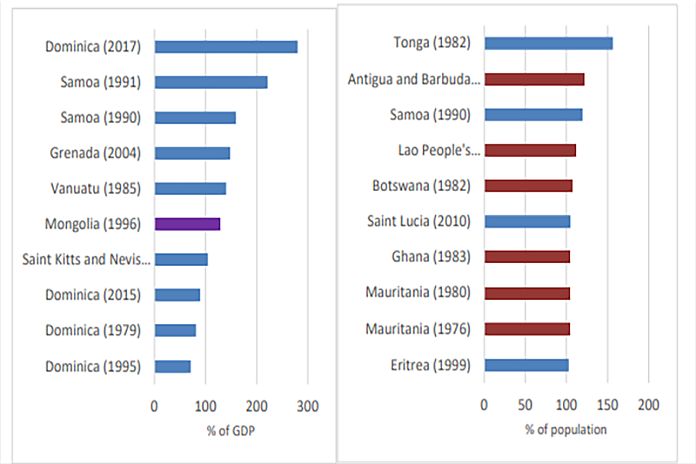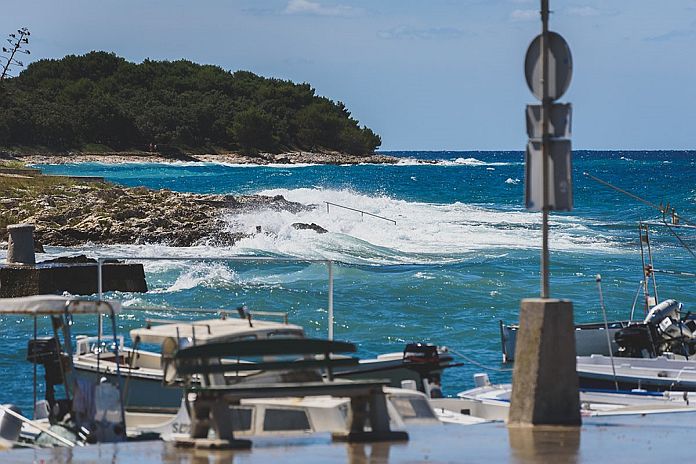
In December 2020 Fiji was pounded by Pacific Cyclone Yasa, the years’ second category 5 storm which destroyed hundreds of buildings and caused about $1.4 billion in damage to health facilities, homes, schools, agriculture and infrastructure.
Yasa was yet another major tropical storm to devastate an island nation in 2020. Similarly, the Atlantic Ocean region saw its most active hurricane season on record.
Small island developing states (SIDS) experience the world’s highest frequency of natural disasters, among them hurricanes, cyclones and other violent storms which lead to severe flooding, and in the worst cases loss of life, homes and infrastructure.
In terms of economic impact, the most severe storm ever, calculated on a per capita basis, hit Dominica in 2017, causing damage equivalent to 280 percent of the island’s GDP, according to the Emergency Events Database (EM-DAT).
For small countries, the costs of post-disaster reconstruction can be exorbitant. On average, natural disasters cause damage equivalent to 2.1 percent of GDP every year in SIDS.
But they also face many other issues, like their small geographic size, remoteness from trade partners and international markets, and a lack of creditor trust, and economic diversification which compounds their ability to bounce back from disasters.
“The international community needs to work hard to help small island nations build resilience as the threat of destruction expands and the cost of seasonal storms becomes increasingly devastating for SIDS,” said Paul Akiwumi, UNCTAD’s director for Africa and least developed countries. “Future disasters could worsen humanitarian crises and impair economic recovery.”
UNCTAD’s special adviser for the blue economy, Dona Bertarelli, said connection to the ocean is both an asset and a risk for SIDS on the frontlines of climate change.
“Global development partners need to work closely with national governments and the private sector to help small island nations build multi-dimensional resilience in the face of both environmental and economic challenges,” she said.
Building resilience for long-term recovery
Greater access to financial support and better disaster debt management is a critical part of a toolbox for resilience.
A recent UNCTAD study on debt vulnerability finds that SIDS have chronic debt not only because of their vulnerability to disasters, but also due to many other structural issues. Disasters are not the only reason for their chronic debt.
“While disasters add to their burden, there are many pre-existing conditions that affect the debt situation in SIDS,” said Akiwumi, highlighting that the study confirms weak statistical links between debt sustainability and disasters alone.
“Prior to COVID-19, SIDS already faced significant constraints in mobilizing sufficient resources to build the necessary productive resources and infrastructure they need for sustainability, on top of financing the costs of disaster recovery,” Akiwumi added.
“If sufficient resources are not available, countries may end up in a trap where low economic activity and poor competitiveness will cause difficulties in paying external debt, endangering a country’s eligibility for future loans.”
Figure 1: Most severe climate-related disaster years, by damage (in % of GDP) (left) and affected people (in % of population) (right), Global, 1970 – 2018

UNCTAD also found that the main drivers of debt sustainability in small islands are per capita GDP, terms of trade, and export diversification.
Stronger economic growth and diversified exports improve SIDS’ capability to manage and repay debts during normal times but become critical in the aftermath of shocks.
COVID-19 exacerbates island vulnerabilities
There is also a looming debt crisis in SIDS in the aftermath of COVID-19 as their tourism-dependent fragile economies are pummelled by travel restrictions. The International Monetary Fund projects a 9% fall in real GDP for SIDS in 2020.
The severe shortfalls in tourist expenditure has led the IMF to anticipate a steep increase in the current account deficit of SIDS to 12.1 percent of GDP in 2020.
The recovery will also be slow. Despite an expected, gradual return of tourism activities, a current account deficit of -12.3 percent of GDP is forecasted for 2021, further straining the capacity of SIDS to service their external debt.
In 2018, the external debt to GDP ratio among SIDS ranged from 6 percent in Timor-Leste to 104 percent in Jamaica. The annual debt service to exports ratio was also greatly unequal, ranging from less than 1 percent in Timor-Leste to 26 percent in Papua New Guinea.
Despite restructuring Granada’s debt and concerted efforts to improve Sao Tome’s fiscal fundamentals, both nations were rated as being in external debt distress in August 2020.
Though not all SIDS are heavily indebted, 17 of them are considered by the IMF as being at “high risk” of debt distress, meaning they would be unable to meet their loan payments.
Innovative policy options
Although some of the IMF emergency financing tools such as the Catastrophe Containment and Relief Trust (CCRT) can provide important debt relief, they require sufficient administrative capacity to measure and report the impact of disasters to prove the eligibility criteria has been met.
This is not an easy job in some SIDS, where quantifying long-term or more complex disasters, like drought, is undermined by weak administrative capacity.
The UNCTAD study identifies a range of policy options that could help SIDS overcome the challenges they face. These include leveraging available international and multi-lateral emergency financing tools, as well as implementing innovative programmes to attract needed revenue, while protecting the countries’ valuable resources.
Some innovative instruments, such as hurricane clauses already included in debt restructuring agreements in Grenada and Barbados, should be extended to other types of disasters going beyond severe storms, the study says.
Multilateral cooperation to increase private insurance coverage against climate change can also support real resilience. For example, the InsuResilience Global Partnership created in 2017 aims to build local capacity and resilience through climate and disaster risk finance and innovative insurance solutions.
The study advises that access to the Green Climate Fund and other programs must be facilitated through a stronger collaboration between traditional and emerging donors to reduce transaction costs.
Technical assistance to national statistical offices is also required to improve the measurement of natural disasters’ impact on economic, social and environmental development.
“Previous approaches have mainly focused on ex-post recovery and emergency-based financing, but ex-ante financing should also be a priority for resilience-building efforts” Akiwumi added.
In addition, agreements between debtor and creditors to reduce a developing country’s debt stock or debt servicing in exchange for a commitment to protect nature, so-called “debt-for-nature swaps”, could be extended by including resilience building to multiple disasters.
“For SIDS, urgent action is needed to protect lives and livelihoods,” Akiwumi said, warning that the world may see more climate refugees as a result. “It is in everyone’s interests to support SIDS now.”





